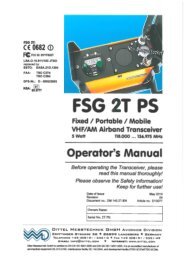EFIS-D6 Installation Guide
EFIS-D6 Installation Guide
EFIS-D6 Installation Guide
You also want an ePaper? Increase the reach of your titles
YUMPU automatically turns print PDFs into web optimized ePapers that Google loves.
Appendix<br />
controller. Remember that even when the controller is powered on, it only heats the probe the<br />
amount necessary to maintain temperature.<br />
The black wire should be permanently connected to ground. Cutting power to the heater<br />
controller should occur via the red power line, not the black ground line.<br />
Heater Status Connection<br />
Note: The probe heater functions properly whether or not you make this connection. It is simply<br />
a status output for your convenience.<br />
The white heater status wire is grounded when the probe heater is turned off or not functioning<br />
properly. This wire should be connected to a light on the panel, whose other terminal is<br />
connected to switched aircraft power. When the heater is on and functioning properly, the white<br />
heater status line is open, leaving the indicator light turned off. When there is no power to the<br />
heater controller – or it is not functioning properly – the white line is grounded, turning the<br />
indicator light on.<br />
Aircraft Spruce P/N 17-410 is an example of a light that will work for this application. An LED<br />
and resistor in series will also suffice. If you use an LED as the indicator, you must choose a<br />
resistor that delivers the appropriate current to the LED, and can accommodate the power<br />
required for its current and voltage drop.<br />
If you own a Dynon EMS-based product, you may also use one of its two contact input to<br />
display an onscreen indication. Connect this heater status output directly to the desired EMS<br />
contact input, with no additional resistors or lights. You must configure the contact display as<br />
described in your EMS-based product’s <strong>Installation</strong> <strong>Guide</strong>.<br />
AOA/PITOT PROBE MOUNTING<br />
The Dynon Avionics AOA/Pitot probe has been designed as an under-wing pitot. The following<br />
information applies to this type of installation. If you wish to mount your pitot on nose boom<br />
mount, contact us so we can make the appropriate adjustments to your pitot. The heated version<br />
of Dynon’s AOA/Pitot Probe does not come in a boom-mount configuration.<br />
AOA/Pitot Probe Mount Location<br />
The Dynon Avionics AOA/Pitot probe only functions correctly when mounted in a location<br />
where the airflow over the probe is relatively undisturbed by the aircraft. In general, we<br />
recommend that you mount it at least 6 inches below the wing and with the tip of the probe<br />
between 2 and 12 inches behind the leading edge of the wing. Typically, pitot probes are<br />
mounted about mid-wing span wise to minimize the effects of both the propeller and the wing<br />
tips. Testing during the probe development has shown that the standard mounting locations for<br />
the pitot probe in the RV series of aircraft also works for the Dynon probe.<br />
AOA/Pitot Probe Mounting Instructions<br />
After the mounting location has been determined, mount the pitot mounting kit per the included<br />
instructions or fabricate your own mount. In either case, mount the probe securely to the wing<br />
such that the body of the probe is horizontal during level flight. Drill and tap mounting holes (#6-<br />
32) on the probe to match your mounting bracket. Use caution when drilling the holes, ensuring<br />
that you avoid drilling into the pitot and AOA pressure lines. As long as you do not penetrate<br />
<strong>EFIS</strong>-<strong>D6</strong> <strong>Installation</strong> <strong>Guide</strong> 5-11
















